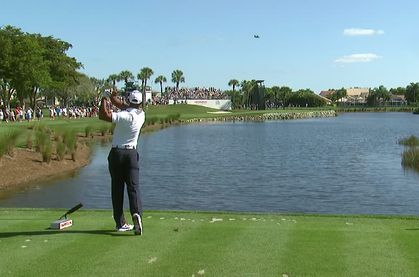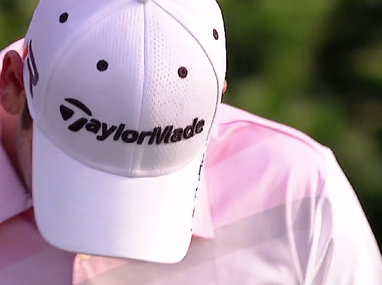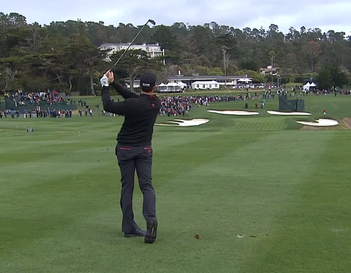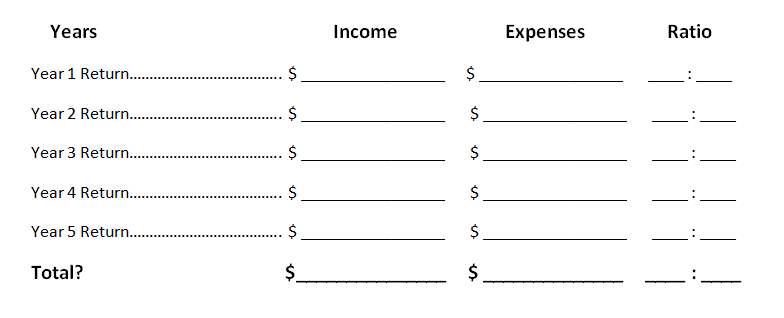Why You Should Never Make a Golf Swing Change Until You Perform a Benefits to Costs Analysis First15/3/2014
"Many tour players have fallen into the trap of investing time, effort and dollars trying to swing the golf club quite differently compared to their authentic or original style, and they end up playing no better, or sadly a lot worse as a result."  Nick Faldo changed his golf swing style and improved a lot! Nick Faldo changed his golf swing style and improved a lot! What is the real cost of improving your golf swing? In other words, how much does it really cost you to improve your golf swing, so you can keep finding ways to improve; and you really have to ask the question, is it really worth all the effort? You need to seriously weigh up the cost of golf swing improvement against the benefits you think you might gain. Why? It just makes good sense to strive to receive a good return on your investment from the time, effort and money you invest in yourself. I’m sure you would agree. This is a given in the business world where individuals routinely invest in themselves by continuously educating themselves so they can gain better opportunities in the market place, and in golf it should be no different. You spend your time, your effort and your money to get better; it is as simple as that. Think of golf improvement as an investment, and there are good investments and there are bad ones. Your responsibility is to focus on the investments that bring in the best returns for the time, effort and money you invest. So what’s a good investment? A good investment is learning and acquiring any golf skill or activity that greatly enhances your performances on the golf course when it matters most to you. Being able to hit a certain type of shot under pressure, and producing consistently excellent results using the method would be an example of this. What’s a bad investment? A bad investment is any golf skill or activity you learn and acquire that does not improve your performances on the golf course when it really matters most to you.  Tiger has probably changed his golf swing style more than any other tour golfer Tiger has probably changed his golf swing style more than any other tour golfer For example, changing your golf swing style to a method that is popular at the moment can be a big mistake. For all those golfers you read about in a golf magazine that made a change to their golf swing and played better, there are many who never see a return on their investment of time, effort and money. Yes golf magazines will always highlight the stars like Nick Faldo, Tiger Woods and Greg Norman who all changed their golf swing styles to some extent and went on to achieve more fame and glory. But what’s interesting about these three examples (and relevant to this article) is that these great golfers all had enormous financial resources behind them when they made changes to their golf swings, and so playing some ordinary golf whilst they were changing their style didn't make much of a dent to their bank accounts. This is especially important when you are going through the transition stage from old golf swing style to new golf swing style and the familiar 'feels' you rely on to play confidently with go missing! This is an important point as you will soon see. Many tour players have fallen into the trap of investing time, effort and dollars trying to swing the golf club quite differently, compared to their authentic or original style, and they end up playing no better, or sadly a lot worse as a result. This would be an example of a bad investment, if after making the changes and competing with them you are no better off than you were before. Weighing Up the Benefits Against the Costs If you are considering a change to your current golf swing style to a popular style of the moment, we think you should at least perform a simple benefits to costs analysis to see whether it is a good investment of your time, effort and dollars, or a bad one. Let’s assume in this example that you are a tour player with a wife and a new baby, and you have been playing on a minor golf tour for 5 years, and for the past 2 years you have kept your card and last season you earned 100,000 dollars. After expenses and taxes your net income was about 70,000 dollars.
 Don't Let Emotion Make the Decision As you weigh it up all you can see is upside and you don’t really consider the consequences of a decision like this. In this mind-set it's hard to see the downside because as soon as you think about the negative consequences you immediately picture yourself winning bigger checks and playing good enough to get onto the major tour, and it feels good. This is a big mistake because the thing to remember is that this should be a business decision first and foremost, and not an emotional one. Emotions will drive you towards making a decision without always weighing up the real cost of the potential investment. Benefits to Cost Analysis So in this situation you need to perform a simple benefits to costs analysis to determine whether this change in instructor and swing style is right for you. Remember that when a tour professional (or prospective tour professional) is weighing up a decision like this, they understand that the benefits are always economic benefits. In other words, you play a lot better and make more money by making the golf stroke changes. Contrast this with what some elite amateurs and professional golfers see as benefits; an improved looking swing style and better ball striking. These two examples of benefits are poles apart. It's the old "golf score versus golf swing" chestnut. Just because a golf swing looks different, and you hit the ball better, doesn’t necessarily mean that you will play better, or make more income. If you undertake changes to your golf swing, it is because you want to experience considerable improvement in your performance on the golf course. That’s obvious, but your score average should be better, and your income greater after taxes and expenses.
So let’s look at it now and work out the real cost of changing golf instructors, and the possible implications of this golf swing change. In formula form here’s the benefit / cost ratio (BCR): By making the golf swing changes what are the annual economic benefits going to be? For every dollar you invest in changing and improving your golf swing technique how many dollars do you get back? Currently the annual realized rate of return on the investment of time, effort and money is 100,000 dollars with expenses of about 30,000 dollars. So your net income is 70,000 dollars. So if you asked the new golf instructor what he conservatively forecasts the annual increased rate of return on the investment to be if you make the change to your golf swing style, based on full commitment to making the changes over 5 years what would it be? We suggest that you sit down with the instructor and fill out the following table to forecast earnings potential as a result of making this golf swing change. If the instructor is not willing to go through this with you because he is more focused on the change to your golf swing and not discussing the potential downside of the changes to your golf swing, then think carefully, and strongly consider your options going forward. There is always downside! A one to one ratio and our tour golfers earnings equal the costs of making the changes. That is, his costs associated with making the changes, as well as normal on tour and off tour expenses equal his benefits (income). He is no better off in a 1:1 scenario as his income is the same as the costs of making the changes. Break even should never be the goal, and if the technique that the instructor is selling you is good enough, then you should expect a better rate of return than this. Remember benefits are economic benefits, or income earned as a result of making the changes. It can only be more or less, and there is a very real cost associated with not playing good enough. Expenses don’t become less just because you are going through changes to your technique, they stay the same or they increase, so if expenses are going to be greater than your income, you have a problem looming. Now our tour golfer considers the consequences carefully because his lifestyle and that of his families is tied in to his current annualized earnings, which covers his living expenses on tour and off tour. And a portion of the 100,000 dollars he earns goes towards his budget for playing the tour the following year. So if his rate of return is 1 to 1 (1:1) then in the first year there is no benefit from making the changes. A ratio of two to one means that his earnings are twice that of his costs. And similarly the ratio can be flipped where expenses are twice that of earnings.  Obviously the goal is to achieve earnings much greater than expenses (otherwise why make the change?) but there would have to be a significant change in his score average, percentage of cuts made and income earned. And this is highly unlikely in year one if he undertakes a major golf swing change. Can our tour golfer afford to play poorly (compared to his current standard) until his changes are habituated and his scores in tournaments improve? Let’s look at the downside for a moment. What if the cost of making the golf swing change greatly outweighs the benefits of making the change, what then? What if it takes a full 2 years for the golfer to start playing better than his current standard? Can he afford to miss more cuts, and make less income in his pursuit of learning and acquiring the new golf swing method? And what if he loses his playing status on tour and now doesn’t have a tour to play on? You can see that there are far reaching affects (positive and negative) if you make the changes, and you should know that for every golfer who plays better as a result of dramatically changing their swing style, there are many who never see the benefits economically, or otherwise. Remember, if you are making the decision based mostly on how you feel about your game (without going through a simple benefits to costs analysis) then you might be heading into some trouble down the road.
Comments are closed.
|
Archives
June 2019
|
Proudly Supported By
Copyright © 2011 - 2018 Pro Tour Golf College
Website Managed By Golf Performance Media
All Rights Reserved
Website Managed By Golf Performance Media
All Rights Reserved






 RSS Feed
RSS Feed



